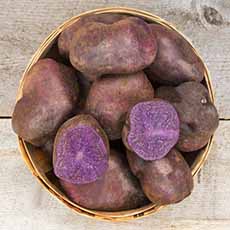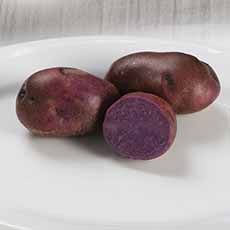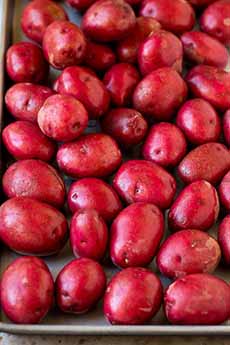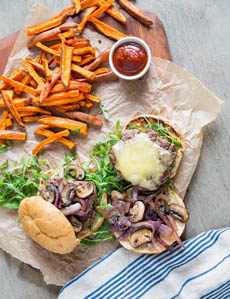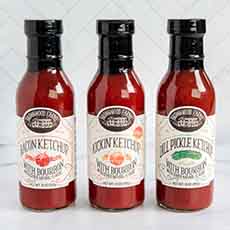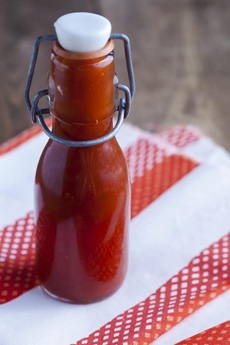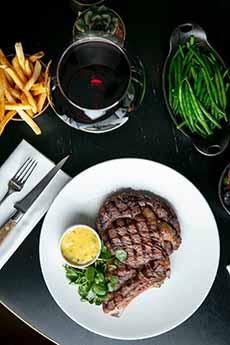|
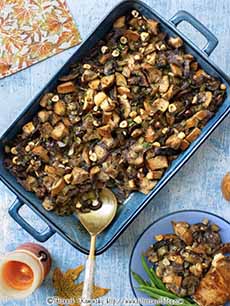
[1] A delicious vegetarian/vegan stuffing with dried and fresh mushrooms (photo © Hannah Kaminsky | Bittersweet Blog).
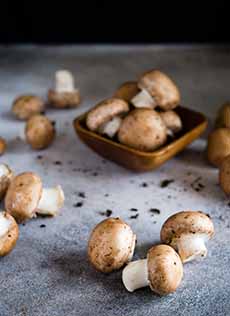
[2] Fresh cremini mushrooms (also spelled crimini) can be replaced with white button mushrooms (photo ©Christine Siracusa | Weusual | Unsplash).
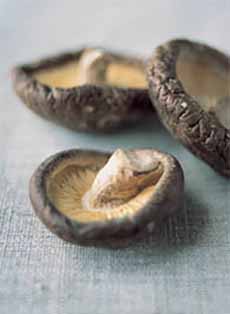
[3] These are fresh shiitake mushrooms (photo © Hannah Kaminsky | Bittersweet Blog).

[4] These are dried shiitake mushrooms (photo © Umami Information Center).
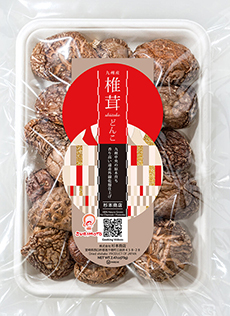
[5] This is the favored brand of recipe developer Hannah Kaminsky. You can find them on Amazon (photo © Sugimoto).
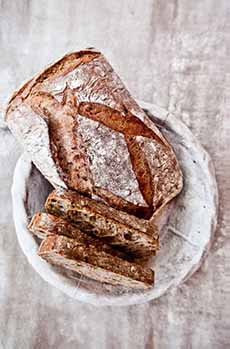
[6] Use a sourdough loaf or an Italian loaf for the bread cubes (photo © Maison Kayser).
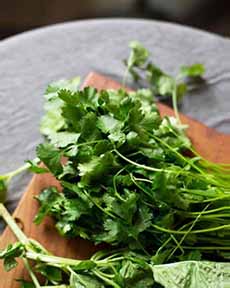
[7] Use fresh parsley, never dried. Flat or curly: it doesn’t matter (photo © Cava Mediterranean Restaurant).
|
|
We love stuffing. We’d rather have stuffing than the turkey. When the last bit of turkey is gone, we know we’ll have more, sometime soon. But we never get around to making another pan of stuffing (stuffing? dressing? see the difference below).
Here’s a mushroom stuffing recipe from Hannah Kaminsky of Bittersweet Blog that everyone will enjoy—including vegetarians and vegans.
She’s particularly fond of the dried shiitake mushrooms from Sugimoto in Japan (they have a U.S. website and are also on Amazon).
SUGITAKE DRIED SHIITAKE MUSHROOMS
Shiitakes are Japan’s favorite mushrooms. In certain preparations, dried Sugimoto shiitake mushrooms are a better choice than fresh ones for several reasons. They have much better flavor, enhanced nutritional attributes, and of course, will last a lot longer in your kitchen.
By removing the moisture, dried mushrooms are naturally preserved to keep longer, without the need for refrigeration, making them an indispensable pantry staple.
Fresh mushrooms must be kept in the fridge for about a week, two at the most, while dried Sugimoto shiitake will keep perfectly at room temperature for at least a year, springing back life as good as new when needed.
Long used in eastern medicines as natural supplements, shiitake mushrooms are rich in many vitamins and nutrients. But only when dried can those elements be concentrated and better absorbed. The drying process breaks down proteins into amino acids and transforms ergosterol into vitamin D.
The drying process also creates a concentration of tastes and provides glutamate, boosting their umami flavor.
“Of course,” says Hannah, “most importantly for their culinary value, Sugimoto shiitake mushrooms are incredibly delicious because the drying and rehydrating process produces guanylate, a natural umami enhancer. Guanylate amplifies the umami taste of all foods, making dishes richer, bolder, and simply better.
“That’s a whole lot to be thankful for right there. It should go without saying that these powerful little mushrooms definitely deserve a place of honor in your stuffing. I’ve got the perfect dish to grace your menu right here.”
RECIPE: BROWN BUTTER MUSHROOM STUFFING
Tangy sourdough and umami mushrooms are the foundation of this hearty, comforting stuffing. Infused with autumnal herbs and nutty browned butter, it’s a side dish you should invite over for Thanksgiving dinner.
You can also enjoy it any time of the year. There’s nothing seasonal about mushrooms, sourdough, and stuffing.
The flaxseeds are very high in fiber with a good amount of protein and a charming flavor. They’re also rich in heart-healthy fat. You can omit them if you like
Prep time is 20 to 30 minutes soaking time for the mushrooms, 15 minutes more for the other ingredients. Cook time is 35 to 45 minutes.
To make ahead of time, the stuffing may be prepared up until the final baking stage 1 day in advance; cover and chill until ready to bake.
We tried the recipe with 2-day-old challah instead of sourdough, also delicious. Just make sure you toast it first to get the bread cubes more dry and crisp.
Ingredients
2.15 ounces dried shiitake mushrooms, soaked overnight
1 pound sourdough or Italian bread, cut into 1/2-inch cubes
1/2 cup butter butter (substitute vegan butter as desired)
1 medium red onion, quartered and thinly sliced
4 stalks celery, diced
1 pound cremini or button mushrooms, sliced
4 cloves Garlic, minced
2-1/2 teaspoons poultry seasoning
1-1/4 teaspoon salt
1 teaspoon ground black pepper
2 tablespoons ground flaxseeds
1 tablespoon apple cider vinegar
3 cups shiitake soaking water and/or mushroom stock
1/2 cup hazelnuts
1/4 cup fresh parsley, minced
Preparation
1. SOAK the mushrooms in 3 cups of water for 20 to 30 minutes. Drain the mushrooms but reserve the liquid. Separate the caps from the stems; slice the caps and finely mince the stems. Set aside.
2. PREHEAT the oven to 350°F. Spread the cubed bread pieces as a single layer on two baking sheets, making sure the cubes don’t overlap. Bake for 10 to 15 minutes, stirring halfway through, until evenly toasted. Set aside and increase the heat to 375°F.
3. SET a large saucepan over medium heat and add the butter. Once melted, the butter will begin to foam and sizzle around the edges. Continue stirring, gently but continuously, for about 5 to 8 minutes. The butter will turn golden brown and begin to smell nutty.
4. ADD the onion, celery, cremini or button mushrooms, shiitake, and garlic. Cook, stirring often, until the vegetables have softened and become highly aromatic, 10 to 13 minutes. Add the poultry seasoning, salt, and black pepper, cooking for 1 minute longer to incorporate.
5. TURN off the heat and sprinkle in the flaxseeds, tossing the vegetables to coat. Introduce the toasted bread and stir well to evenly distribute all the ingredients. Transfer to a larger bowl if needed to stir properly.
6. ADD the vinegar, shiitake soaking water and/or stock if needed, hazelnuts, and parsley. Mix well, making sure everything is thoroughly incorporated. Transfer the mixture to a 13 x 9-inch baking dish, spreading it out in an even layer.
7. BAKE for 35 to 45 minutes, until golden brown all over. Let stand 10 minutes before serving.
STUFFING OR DRESSING: THE DIFFERENCE
It’s simple:
Stuffing is cooked inside the bird.
Dressing is cooked in a separate pan.
While the idea of stuffing the bird appeals to many, most experts recommend cooking a separate dressing.
For food safety reasons, stuffing in the cavity of the bird must reach the same 165°F temperature before it is ready to serve. If you have a vegetarian dressing, it’s not an issue.
(But if you have a dressing made with raw meat or seafood, do make sure it cooks to 160°F.)
It’s also a heck of a lot easier to make dressing, both in placing it in a pan instead of spooning it into the turkey cavity; and in avoiding the labor of scooping the stuffing out of the bird.
There may be regional traditions that select one term or the other. We grew up in the northeast, where it was always “stuffing,” no matter whether in the bird or in a casserole dish.
“Dressing” referred to salad dressing.
MORE STUFFING RECIPES
Allow us to use the words interchangeably in the recipe names. The cook decides if it’s going to be stuffing or dressing!
Chestnut, Fig & Honey Stuffing
Chicken Liver Stuffing
Oyster Dressing
Panettone Stuffing
|



